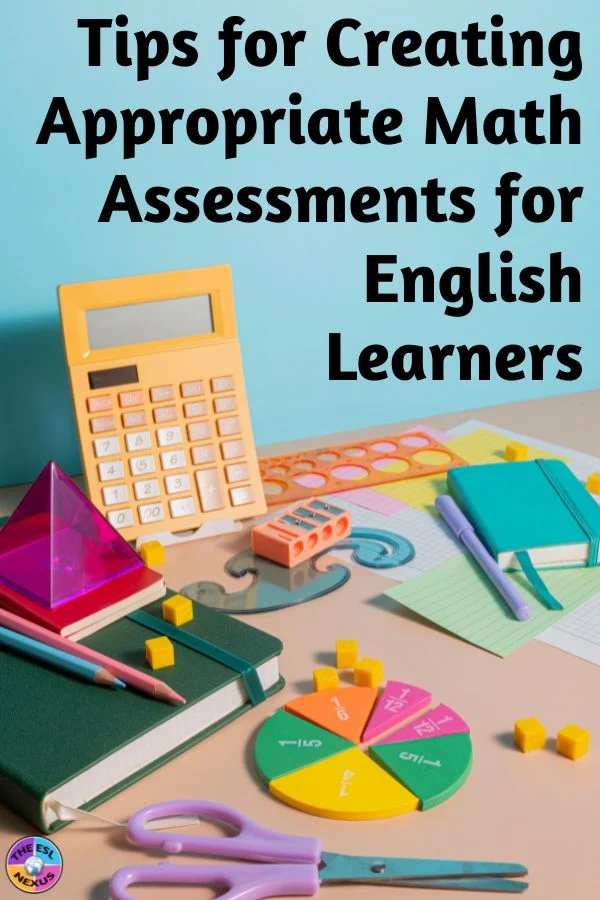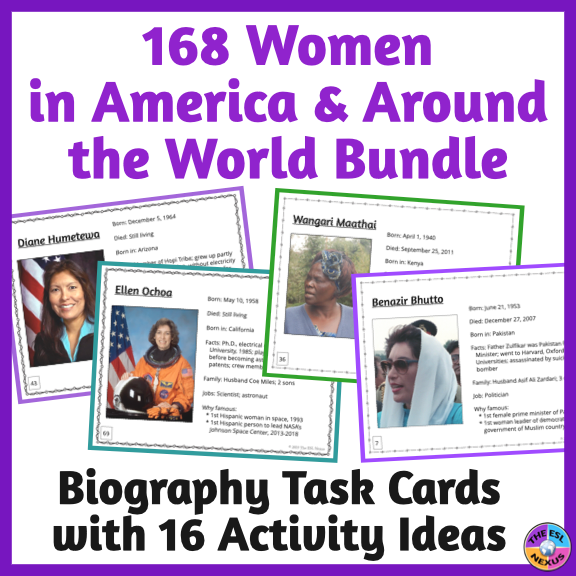You might think that creating math assessments is easier than creating other types of assessments because math is a universal language. But although there are many math symbols and figures that mean the same thing across languages, the way math problems are solved and the way numbers are written is not always the same. A blog post I wrote a few years ago explains some of the differences. Today, I'd like to zero in (pun intended!) on how to design well-crafted math assessments that take into account the different language proficiency levels of Multilingual Learners of English.
First, I'll take about 5 important factors (another pun, sorry!) to consider when creating your math assessments and explain why they're important. Then, I'll offer some examples of math assessments for students at different levels of language proficiency. At the end of this blog post, I'll include links to a couple math books that I found really helpful when I was providing math support to ELLs.
 |
Keep reading for tips on how to design good math assessments; graphic created by The ESL Nexus
|
Guidelines to Keep in Mind
1) Use Clear Language
Make sure that text in the directions and in the problems is easy to understand. Differentiate the language based on the proficiency of the English Learners in your class. You want to be assessing your students' knowledge of math, not English, and if they don't understand what they are asked to do, you won't be evaluating their math understanding.
So, use very simple language. Don't use sentences with complicated grammar structures. Be sure to include examples and models to students to help students' comprehension. Using visuals as much as possible will help with this.
2) Use Real-Life Situations
Connect problems and examples to students' lives. Doing that helps make the concepts easier to understand because they will be relevant to students' personal experiences.
Think of examples that relate to students' daily lives. That will help them see the practical applications of the concepts being assessed.
3) Use Multiple Ways to Show Concepts
Show math ideas in more than just one way. This helps students who have different ways of learning. It also helps them better comprehend what they're being asked to do because multiple representations make it more likely the concepts will resonate.
You can do this by including visuals, manipulatives, and pictures in your math assessments. Also, allow students to give their answers in multiple ways because that makes it easier for them to express themselves. Students can use drawings, tables, and graphs as well as sentences to explain what they mean. For beginning proficiency learners, orally providing answers is also helpful.
4) Use Culturally Responsive Material
Incorporating culturally appropriate and diverse examples in math assessments helps students connect to the concepts being tested. It also helps create an inclusive classroom atmosphere that makes English Learners more comfortable and supports their learning.
You can do this when using names of people in word problems – include names commonly used in your students' native countries. When talking about places or buildings, reference other cultures' or countries' well-known locations. If you're using food in word problems, instead of talking about meat and potatoes, for example, talk about rice and beans instead.
5) Use Focused Feedback
When giving feedback about test results, make sure it is constructive and is in language that students can understand. Focus on the math aspects, not language errors; if the math is correct but the language is not, count the problem as correct.
Tailor your feedback to students' language proficiency levels. Use visuals and/or give oral feedback to students with lower levels of English language proficiency. Be sure to include comments about what was done correctly because that provides encouragement.
Examples of Differentiated Math Assessments
This section gives 4 examples of assessments that ask students to demonstrate their understanding of various math concepts that you have already taught. Each example states the concept being assessed and then offers ideas of what to write to assess that concept. The first 2 examples are for elementary students and the last 2 are for middle school students. For each concept, examples are given for ELLs at beginning, intermediate, and advanced levels of English language proficiency.
Elementary Concepts
1) Counting
Task: Look at a picture. Count the number of bananas in the picture. Write how many bananas are in the picture.
Beginning: Show a picture of 3 bananas. Answer is the number "3."
Intermediate: Show a picture of 3 bananas. Answer is the word "three."
Advanced: Show a picture of 3 bananas and 2 oranges. Answer is "3 bananas" or "three bananas."
2) Calculating the cost of something using multiplication
Task: When given the price of 1 item, calculate the total cost of 4 of those items when the price is the same for each one.
Beginning: Show a picture of flip flops with the price under each one.
Intermediate: Write a simple word problem, such as the following and include pictures of flip flops: Solve this problem. If one shoe costs $5.00, how much do 4 shoes cost
Advanced: Write a word problem with more complex language and ask students to show how they got their answers. For example: You are going to the store to buy shoes. You see flip flops that you like. Each flip flop costs five dollars. How much will 4 flip flops cost?
Middle School Concepts
1) Calculating area
Task: Determine the area of a vegetable garden that measures 8 feet by 25 feet.
Beginning: Show a picture of a rectangular garden with the measurements on all sides.
Intermediate: Write a word problem, such as: Mariama grows vegetables in a garden that measures 8 feet by 25 feet. What is the area of her garden?
Advanced: Mariama grows vegetables in a garden that measures 8 feet by 25 feet. She wants to know how big her garden is. Explain the steps that Mariama has to do to find the area of her garden.
2) Comparing fractions
Task: Put the fractions 1/2, 2/3, and 3/4 in the correct order.
Beginning: On the assessment, show pictures of items that are cut into various pieces representing the fractions such as a pencil and a piece of fruit. On the other side of the paper, write the three fractions. In the directions, tell students to match the numbers with the correct pictures.
Intermediate: Write a word problem that asks students to put the fractions in order from smallest to largest. For example: Angela, Mehmet, and Guillermo are making food for their school's international night. Angela's recipe needs 1/2 a cup of rice, Mehmet's recipe needs 2/3 of a cup of yogurt, and Juan's recipe needs 3/4 of a cup of hot sauce. Which recipe uses the least food? Which recipe uses the most food? Put the fractions in order from smallest to largest.
Advanced: In art class, students are drawing patterns after looking at pictures of mosaics from around the world. Sara used 3 1/2 tiles in a Moroccan design. Sayeed used 2 3/4 tiles for his Turkish design. Rana used 1 2/5 tiles in her Indian design. Write how many tiles each student used as a proper fraction, then put them in order from least to greatest. Explain or show how you got your answer.
Useful Math Books
I used both of these books and found them very helpful. They're not newly published but they offer good support. I think they're especially helpful for teachers who don't have real strong math backgrounds, which may the case if you teach more than one content subject.
(The links for the books are affiliate links. That means that I make a small commission if you purchase the books but it's at no additional cost to you. Thank you for your support!)
1) Access Math by Great Source is aimed at teaching math to multilingual learners of English in Grades 6-8. However, 5th graders might also benefit from using it if they are learning the concepts covered in the book. There are 12 chapters. Topics begin with Number Concepts, and then proceed to Introduction to Algebra, Decimals, Number Theory, and Fractions and Mixed Numbers. That's followed by Ratios, Proportions, and Percents. Other topics include Data and Statistics, Geometry, Area and Volume, Probability, Integers, and finally More Algebra. Access Math incorporates lots of language learning in each chapter and the book is visually appealing with lots of color photos.
2) Strategies for Test-Taking Success: Math, published by Thomson Heinle, is not aimed specifically at MLEs but I used it with my ELLs in Grades 5 -8. What I really like about it is that it teaches students how to solve math problems. It presents strategies for doing different types of math problems, explains the meaning of the vocabulary used in the problems, gives examples, and then has students practice using the strategies by doing practice tests. The first chapter of Strategies for Test-Taking Success: Math discusses various types of questions and test-taking strategies. The remaining chapters cover these topics: Whole Numbers and Number Sense; Fractions, Decimals, and Percents; Algebra; Probability, Data, and Statistics; and Geometry.
I hope all this information helps you more easily create math assessments for all the Multilingual Students of English, regardless of their language proficiency level. Earlier blog posts in this series about creating appropriate assessments for ELLs include How to Create Appropriate Classroom Assessments for Different Levels of Language Proficiency and How to Create Appropriate Social Studies Assessments for English Language Learners.








